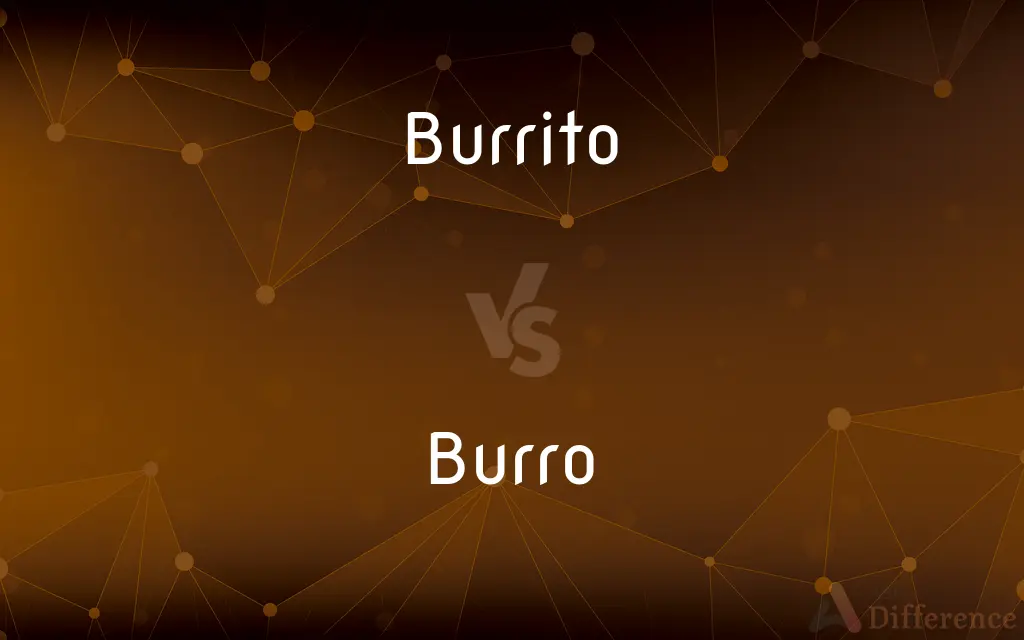Burrito vs. Burro — What's the Difference?
By Urooj Arif & Maham Liaqat — Updated on March 22, 2024
A burrito is a Mexican dish consisting of a flour tortilla filled with various ingredients, while a burro is the Spanish word for donkey and refers to an animal.

Difference Between Burrito and Burro
Table of Contents
ADVERTISEMENT
Key Differences
A burrito is known for its culinary versatility, allowing for a wide range of fillings such as beans, rice, meat, and vegetables, all wrapped in a soft flour tortilla. This makes it a popular choice in Mexican and Tex-Mex cuisine, where customization is key. On the other hand, a burro, meaning donkey in Spanish, plays a significant role in various cultures as a beast of burden. These animals are known for their strength, endurance, and ability to navigate difficult terrains, which contrasts with the culinary delight and convenience offered by a burrito.
While burritos are a staple in fast food and sit-down restaurants alike, celebrated for their convenience and the way they perfectly encapsulate a variety of flavors in every bite, burros have been historically valued for their contributions to agriculture and transportation. This illustrates the contrasting realms these terms belong to—one to the culinary world and the other to the animal kingdom.
Burritos often symbolize the fusion of different culinary traditions, incorporating elements from Mexican, American, and other international cuisines, which reflects the globalization of food culture. Conversely, burros are emblematic of traditional modes of life and labor, especially in rural settings, where they continue to be relied upon for their practical utility.
The enjoyment of a burrito can be a personal and sensory experience, influenced by individual taste preferences and the creativity of its preparation. Burros, however, evoke a connection to the natural world and to traditional ways of living, where their presence is often associated with simplicity and reliability.
In terms of environmental impact, the production and consumption of burritos involve considerations of agricultural sustainability, food miles, and waste generation. Meanwhile, burros, as living creatures, require care, habitat, and resources, presenting a different set of environmental and ethical considerations.
ADVERTISEMENT
Comparison Chart
Category
Food
Animal
Primary Use
Eating
Working/Transportation
Origin
Mexican Cuisine
Domesticated in various cultures
Symbolism
Culinary diversity and innovation
Strength, endurance, and traditional labor
Environmental Consideration
Agricultural sustainability, food miles
Habitat, care, resources, ethical considerations
Compare with Definitions
Burrito
A Mexican dish of a flour tortilla rolled or folded around a filling.
I ordered a chicken burrito with extra guacamole.
Burro
Known for its hardiness and ability to carry heavy loads.
Burros are invaluable for navigating the mountainous terrain.
Burrito
A symbol of Tex-Mex cuisine, blending Mexican and American tastes.
Burritos represent the fusion of cultures in every bite.
Burro
Symbolizes simplicity and endurance in various cultures.
The burro has long been a symbol of perseverance.
Burrito
Often served with sides like salsa, sour cream, or cheese.
A burrito isn't complete without a side of spicy salsa.
Burro
Requires care, including feeding and habitat.
Taking care of a burro involves ensuring it has enough space to roam.
Burrito
A popular fast food item featuring a combination of ingredients like meat, beans, and rice.
Burritos make for a quick and satisfying meal.
Burro
Often associated with rural and agricultural settings.
Burros are a common sight in the countryside, assisting with farm work.
Burrito
Known for its portability and versatility in fillings.
The best thing about a burrito is how customizable it is.
Burro
A small domesticated member of the horse family, used as a working animal.
The farmer relied on his burro to carry goods to the market.
Burrito
A burrito (English: , Spanish: [buˈrito] (listen)) is a dish in Mexican and Tex-Mex cuisine that took form in California cuisine, consisting of a flour tortilla wrapped into a sealed cylindrical shape around various ingredients. The tortilla is sometimes lightly grilled or steamed to soften it, make it more pliable, and allow it to adhere to itself when wrapped.
Burro
A small donkey used as a pack animal.
Burrito
A flour tortilla wrapped around a filling, as of beef, beans, or cheese.
Burro
A small donkey, especially one used as a pack animal.
Burrito
A Mexican dish consisting of a flour tortilla wrapped around a filling of meat and/or beans, cheese etc.
Burro
(Slang)A drug smuggler who swallows bags filled with a drug, especially heroin or cocaine, to avoid detection by drug enforcement officers or customs officials.
Burrito
(slang) To wrap someone or something up like a burrito.
Burro
A small donkey, especially when used as a pack animal or one that is feral and lives in the southwestern United States or northern Mexico.
Burrito
A flour tortilla folded around a filling.
Burro
A donkey.
Burrito
A flour tortilla folded around a filling
Burro
Small donkey used as a pack animal
Common Curiosities
What are common fillings for a burrito?
Common fillings include rice, beans, cheese, salsa, meat, and vegetables.
What is a burrito?
A burrito is a dish made with a flour tortilla filled with various ingredients like beans, meat, and vegetables.
What does "burro" mean?
"Burro" is the Spanish word for donkey, an animal used for transportation and labor.
Are burritos only Mexican cuisine?
While originating from Mexican cuisine, burritos are popular in various forms worldwide, especially in Tex-Mex cuisine.
How are burros used in agriculture?
Burros are used for transporting goods, plowing fields, and as companions for other livestock.
How long can a burro live?
Burros have a lifespan of around 25 to 30 years, depending on care and environment.
Can burritos be frozen for later consumption?
Yes, burritos can be frozen and reheated, making them convenient for meal prep.
What's the difference between a burro and a horse?
Burros are smaller, have longer ears, and are generally hardier than horses, suited for carrying loads over rough terrains.
Can burros be pets?
Yes, burros can be kept as pets, but they require appropriate care, space, and socialization.
Is a burrito healthy?
A burrito's healthiness depends on its ingredients; it can be made healthier with choices like lean proteins, whole grains, and fresh vegetables.
Are there vegetarian options for burritos?
Absolutely, vegetarian burritos can include fillings like beans, rice, vegetables, and plant-based proteins.
What are the environmental impacts of raising burros?
The impact includes land use for grazing and the resources needed for their care, but they can also contribute positively by aiding in sustainable farming practices.
Do burros require special care?
Yes, like all animals, burros require proper nutrition, veterinary care, and a suitable living environment.
Can burritos be considered a complete meal?
Yes, when filled with a balance of protein, grains, and vegetables, burritos can serve as a nutritious and satisfying meal.
How did burritos become popular in the United States?
Burritos gained popularity through the spread of Mexican and Tex-Mex restaurants, appealing to a wide range of tastes with their versatility.
Share Your Discovery

Previous Comparison
Castle vs. Cottage
Next Comparison
Barberry vs. BayberryAuthor Spotlight
Written by
Urooj ArifUrooj is a skilled content writer at Ask Difference, known for her exceptional ability to simplify complex topics into engaging and informative content. With a passion for research and a flair for clear, concise writing, she consistently delivers articles that resonate with our diverse audience.
Co-written by
Maham Liaqat















































